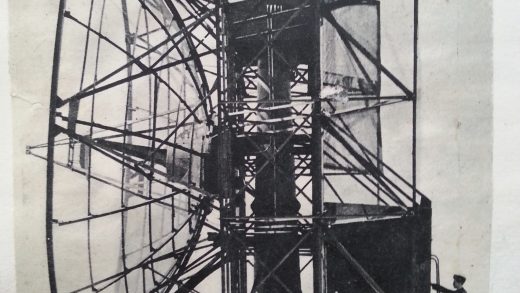A lot of women I know (and you know too) seem to be often pre-occupied with a threatening rival. In the 1940’s it might have been the red-haired Rita Hayworth or the slinky blonde on the bus or the bar-maid at the local pub. Today, some see ‘Footy’ as their rival; some- just a small white golf ball. But for me, in 1944/45, I have a sneaking suspicion that it was that ‘grand lady of the skies’-the Lancaster, and, in particular, one named “O” Oboe from 460 squadron at Binbrook, Linconshire. The nearest we get here in OZ to the feeling of a ‘Lanc’ is when we see one at close hand such as ‘G’ George by name in Canberra. We have a look inside and wonder how, in that long interior of the aircraft frame, crammed with instruments, with guns, wireless, radar, bomb-sights etc., anyone in a clumsy padded flying-suit could move about at all. Nevertheless, it is a recorded fact that over 50,000 young men, most of them in their early twenties, lived out their last days and died in such surroundings. All of them who flew knew and accepted that their chances of survival were slim. Two in every three were lost in the early days and one in every three towards the end. One wonders what it was that stimulated and drove them on and made them get into these huge bombers several times a week (while the weather held) as Bomber Command continued to choose targets for attack. Could it have been an on-going love affair with this ‘lady of the skies’? Perhaps not altogether! But, if they had to go in the line of duty, there was no better loved nor more trustworthy companion to carry them on their mission than their own special Lancaster. As World War 2 drew to a close in Europe, Lancaster bombers were engaged for a while in dropping food to starving people in Holland and, after Germany’s surrender, in bringing back to England released prisoners of war from Germany and Italy. Did I ever get really close to my rival? Yes! I did! One morning, whilst I was still at Binbrook, the home of 460 Squadron RAAF, the WAAF Intelligence Officer named Val came into my bedroom early and said, “Would you like a trip over Europe in a Lanc?” I got dressed in a moment, forgot about breakfast, and ran with her to the dispersal where Squadron Leader Frank Lawrence was readying his machine for take-off. When we climbed on board through the back side door and clambered forward to the pilot’s compartment past the Wireless Operator and the Navigator, both already seated in their respective compartments. we came upon Frank and the Flight Engineer about to start the engines. Val took up a standing position beside the Flight Engineer and I squeezed in behind Frank’s pilot’s seat. We taxied out and took off down the long runway. What excitement to hear the roar of the four Merlin engines and to feel the surge of power as the plane gathered speed and then lifted off and soared over the fence at the end of the runway. Still climbing, Frank turned on course for Germany across the North Sea and levelled out at about 1000 to 1500 feet. We flew across Holland, down the Rhine and into the Ruhr, the ‘Happy Valley’ as it was called by the Bomber crews because of the strength of its defences. Southwards we flew, down its whole length and on as far as Wiesbaden and, as I looked out through the perspex windows, I saw the utter devastation of the Ruhr cities and towns. Human beings were moving about like ants amongst the rubble of shattered buildings. Here and there the outer walls of a building would be still standing but none had roofs and all the interior was gutted. Thankfully, for these German survivors it was summer and not winter. Many people since have condemned the British and American Bomber forces for the destruction that they caused, but I had seen for myself what the German bombers had done earlier in the war to parts of London, Portsmouth and Canterbury-not to mention the frightful tragedy of Coventry. It was the Germans who sowed the wind and they reaped the whirlwind. By now it was nearly mid-day and I was starting to feel peckish. I said to Frank, “What’s for lunch?” and he handed me a small Fry’s chocolate bar. Hardly a satisfying lunch for someone who had had no breakfast. I was also beginning to tire after standing up for hours behind the pilot. Behind me was a soft curtain and protruding from it a small ledge just at the right height for my bottom to comfortably rest on. It was nicely warm and got very warm towards the end of the trip. I discovered later that it was the Navigators H2S radar equipment and I was somewhat mortified to learn this as I was a Signals Officer and supposed to be fully aware of the delicate, top secret, highly sophisticated radar equipment that the bombers now carried. After Wiesbaden we turned westward and came back over France. Here there was no sign of bombing-just beautiful countryside, green trees and peaceful crops everywhere-such a dramatic contrast to the picture we had left behind. We landed at Binbrook in the mid-afternoon and I went straight to bed, thrilled but exhausted. Apart from Val, I have never met another WAAF who was granted such an opportunity to fly over Europe in a Lancaster. This was my introduction to this ‘gracious lady of the skies’, a very personal and close-up meeting with a companion of my life-long rival-that other Lancaster named “O” Oboe.


